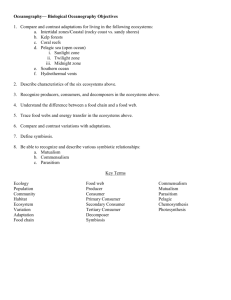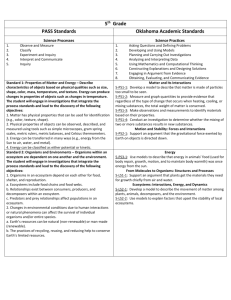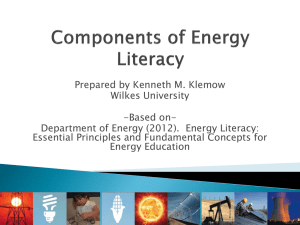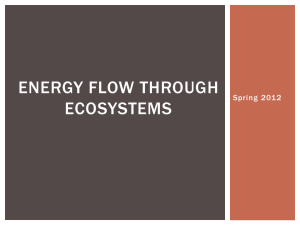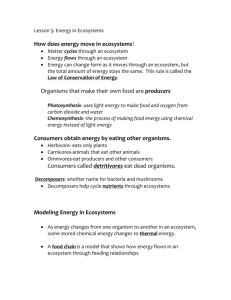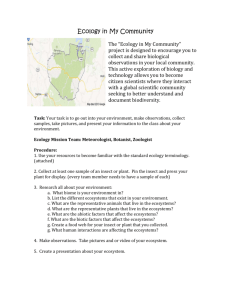Ecosystems Practice Test - Selwyn Elementary 5th Grade
advertisement
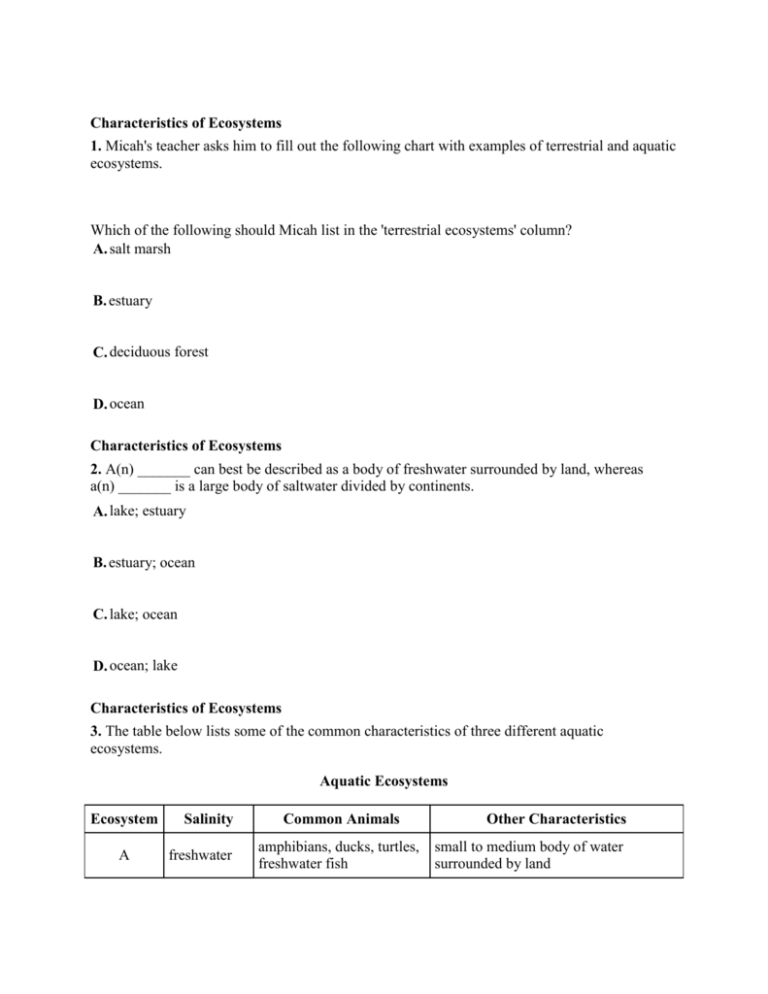
Characteristics of Ecosystems 1. Micah's teacher asks him to fill out the following chart with examples of terrestrial and aquatic ecosystems. Which of the following should Micah list in the 'terrestrial ecosystems' column? A. salt marsh B. estuary C. deciduous forest D. ocean Characteristics of Ecosystems 2. A(n) _______ can best be described as a body of freshwater surrounded by land, whereas a(n) _______ is a large body of saltwater divided by continents. A. lake; estuary B. estuary; ocean C. lake; ocean D. ocean; lake Characteristics of Ecosystems 3. The table below lists some of the common characteristics of three different aquatic ecosystems. Aquatic Ecosystems Ecosystem A Salinity freshwater Common Animals amphibians, ducks, turtles, freshwater fish Other Characteristics small to medium body of water surrounded by land B saltwater jellyfish, whales, sharks large body of water separated by continents C somewhat salty sea birds, shellfish, saltwater crocodiles partially enclosed body of water where salt and fresh water mix Ecosystem A is most likely a(n) _______. A. ocean B. saltwater marsh C. estuary D. lake Characteristics of Ecosystems 4. Where is a beaver most likely to live? A. desert B. ocean C. rainforest D. river Characteristics of Ecosystems 5. The narrow leaves of these plants decrease water loss. They can also live in the windy conditions of this environment. Where do these plants live? A. grassland B. in water C. tundra D. desert Energy in Ecosystems 6. An Antarctic food web is pictured above. If the temperature of Antarctica rose and all of the fish died, what would most likely happen to the number of seals? A. The number of seals would not change. B. The number of seals would increase and then decrease. C. The number of seals would decrease. D. The number of seals would increase. Energy in Ecosystems 7. Strawberry plants, honey bees, mice, and badgers all live in a field. In the food web above, honey bees help the strawberry plants by pollinating them as they take nectar away to eat. Badgers eat mice, and mice eat strawberries. What would happen if honey bees were taken away from this field? Over time, there would be fewer strawberry plants, mice, and badgers. A. B. C. D. Over time, there would be more mice. There would be more badgers. There would be more strawberry plants. Energy in Ecosystems 8. When an earthworm feeds upon the remains of a dead raccoon, it is acting as a _______. A. predator B. decomposer C. parasite D. producer Energy in Ecosystems 9. An organism that makes its own food is known as a _______. A. decomposer B. carnivore C. producer D. consumer Energy in Ecosystems 10. A food chain is shown below. Which of the following is a consumer in this food chain? A. heron B. frog C. grasshopper D. all of these Energy in Ecosystems 11. During the natural cycle of life that takes place in all ecosystems, plants and animals die. What happens after an organism in an ecosystem dies? The body of the organism quickly turns into a new kind of organism. A. B. The body of the organism quickly changes into a gas and becomes part of the air. C. D. The body of the organism decays and is recycled back into the ecosystem. The body of the organism does not change and will stay the same forever. Characteristics of Ecosystems 12. The picture shows a wetland ecosystem like the Everglades. What animal lives in this ecosystem? A. moose B. polar bear C. elephant D. frog Characteristics of Ecosystems 13. The picture above shows a body of water. This body of water is smaller and shallower than a lake. Since it is so shallow, the temperature of the water usually stays the same from top to bottom. What is this body of water? A. pond B. stream C. estuary D. marsh Energy in Ecosystems 14. A food web is shown in the picture above. If a strong storm killed most of the mice in this area, the number of __________ would __________. A. foxes; decrease B. grass seeds; decrease C. foxes; increase D. foxes; stay the same Energy in Ecosystems 15. An organism that feeds upon another organism is known as a _______. A. decomposer B. consumer C. producer D. messenger Characteristics of Ecosystems 16. How are forests different from grasslands? A. Forests usually get more rain than grasslands. B. Prairie dogs and bison live in grasslands but not forests. C. Forests have many trees and grasslands do not. D. all of these Characteristics of Ecosystems 17. The picture below shows some of the features of the ocean where it meets the land. More organisms live in the shallow part of the ocean, which reaches from the coast to the continental slope, than in any other part of the ocean. This is because the shallow parts of the ocean are saltier than the deeper parts. A. B. C. D. the continental shelf blocks sunlight from reaching the shallow parts. the shallow parts of the ocean are colder than the deeper parts. there is more sunlight available in the shallow parts of the ocean. Characteristics of Ecosystems 18. The picture below shows a bison. Where is a herd of bison most likely to live? A. wetland B. rainforest C. grassland D. desert Characteristics of Ecosystems 19. Prairie dogs, bison, and grasshoppers live in ecosystems called _______. A. forests B. oceans C. estuaries D. grasslands Energy in Ecosystems 20. A food web is shown below. Decomposers, such as bacteria, earthworms, and fungi, are not shown in the food web. How do these organisms receive energy? Decomposers use energy from the Sun to make their own food. A. B. C. D. Decomposers do not need energy to survive. Decomposers break down the remains of dead plants and animals. Decomposers consume living plants and animals. Characteristics of Ecosystems 21. The photo below shows mangrove trees growing in a body of water. This image is courtesy of Caroline Rogers, U.S. Geological Survey. Mangrove trees live in shallow water, like that shown in the picture. Unlike most trees, the water that mangroves grow in is salty. Because of this, mangroves are often found on the coast in warm areas. Which of the following ecosystems would a mangrove most likely be found in? A. saltwater marsh B. lake C. pond D. deep ocean Energy in Ecosystems 22. Producers are organisms that use light energy from the Sun to make food. Which of the following is an example of a producer? A. wolf B. mushroom C. deer D. grass Energy in Ecosystems 23. The picture shows a rainforest food chain. If some of the trees are cut down and taken away, how would the number of kinkajous change? A. It would drop to zero. B. It would go down. C. It would not change. D. It would go up. Energy in Ecosystems 24. A food web is shown in the picture above. Which of the following would most likely happen if there was a drought and the grass did not get enough water? A. B. C. D. The rabbits would start eating the foxes, which would cause the number of foxes to go up. The number of rabbits would go up, which would cause the number of mice to go down. The grass would die, which would cause the number of foxes to go up. The grass would die, which would cause the number of mice, rabbits, and foxes to go down. Energy in Ecosystems 25. Which organisms do plants depend on to release nutrients they need into the soil? A. none of these B. herbivores C. carnivores D. decomposers Characteristics of Ecosystems 26. The ecosystem pictured below receives enough rain to support the growth of small shrubs and other low-growing plants. However, the ecosystem does not receive enough rain for tall trees to grow there. Common problems in this ecosystem include drought and wildfires. The picture most likely shows a _______ ecosystem. A. marine B. desert C. grassland D. coniferous forest Characteristics of Ecosystems 27. Where are the plants below most likely to be found? A. rainforest B. desert C. tundra D. grassland Characteristics of Ecosystems 28. What type of ecosystem forms where a freshwater river meets the ocean? A. a pond B. a forest C. a grassland D. an estuary Characteristics of Ecosystems 29. The table below lists some of the common characteristics of three different terrestrial ecosystems. Terrestrial Ecosystems Ecosystem Common Plants Common Animals Other Characteristics A large trees, ferns, bamboo panthers, monkeys, very high average rainfall and capybaras, snakes, spiders warm temperatures year-round B deciduous trees, shrubs, bushes black bears, deer, red foxes, rabbits high average rainfall, has predictable seasonal changes C grasses and small prairie dogs, bison, fertile soil, medium amount of rain shrubs grasshoppers Ecosystem A is most likely a _______ ecosystem. A. rainforest B. grassland C. deciduous forest D. salt marsh Energy in Ecosystems 30. The picture shows a pond food chain. If more beetles are produced one year, which animal population will shrink? A. plant B. bird C. tadpole D. fish Energy in Ecosystems 31. A food chain is shown below. Which organism in this food chain is a producer? A. caterpillar B. plant C. raccoon D. bird Energy in Ecosystems 32. Which of the following is a way that decomposers help ecosystems? A. B. C. D. They release important nutrients into the soil. They are the ecosystem's main source of freshwater. Decomposers do not help ecosystems. They hunt and kill harmful predators like snakes and wolves. Energy in Ecosystems 33. The picture shows a pond food chain. If the birds move to another community, which animal population will grow? A. tadpole B. beetle C. water plant D. fish Energy in Ecosystems 34. Plants use photosynthesis to make ________. A. sunlight B. food C. water D. soil Characteristics of Ecosystems 35. A slider turtle is shown below. This kind of turtle lives in swampy, freshwater areas. They eat small fish, insects, and aquatic plants. Slider turtles spend much of their lives in the water, but they must still be able to get to the surface since they do not have gills. Which of the following aquatic ecosystems would a slider turtle most likely be found in? A. lake B. estuary C. ocean D. saltwater marsh Characteristics of Ecosystems 36. Which animal lives in a wetland environment, like the one shown in the picture above? A. lobster B. cheetah C. duck D. bear Characteristics of Ecosystems 37. Which of the following animals would most likely be found in a deciduous forest ecosystem? W. X. Y. Z. A. Y B. Z C. W D. X Characteristics of Ecosystems 38. A scientist is studying a certain type of plant that requires a hot and humid climate and lots of rain in order to grow. In which type of ecosystem would this plant most likely be found? A. grassland B. tropical rainforest C. desert D. tundra Energy in Ecosystems 39. A food web diagram is shown below. Plants in this food web A. do not require energy to make food. B. consume grasshoppers to receive energy. C. decompose mice to receive energy. D. use energy from the Sun to make food. Characteristics of Ecosystems 40. Which of the following animals is most likely to be found in a rainforest? seal camel penguin monkey A. penguin B. monkey C. seal D. camel Energy in Ecosystems 41. The picture shows a rainforest food chain. If more termites moved into the community, how would the number of kinkajous change? A. It would go down. B. It would not change. C. It would drop to zero. D. It would go up. Energy in Ecosystems 42. The food web below shows the plants and animals that live in a pond and some nearby grass. What would probably happen if the frogs were taken away from the pond? A. There would be fewer aphids and grasshoppers. B. There would be more aphids and grasshoppers. C. The pond would dry up. D. There would be fewer aphids, but more grasshoppers. Energy in Ecosystems 43. A decomposer is an organism that gets its energy from A. B. C. D. the prey it hunts and kills. living organisms. dead plant and animal matter. the food it produces during photosynthesis. Energy in Ecosystems 44. Haley knows that plants and animals are made up of many different materials. She wants to know how these materials can cycle through an ecosystem. What question could Haley ask to learn more about this topic? A. B. C. D. What kind of plant should Haley buy her mom for her birthday? What happens to the materials that make up a living organism after it dies? What will happen to a sunflower plant if it is grown in a dark closet? What kind of organism is the most popular at Haley's school? Characteristics of Ecosystems 45. Which animal is most likely to be found in a river? A. shark B. tuna C. trout D. starfish Characteristics of Ecosystems 46. How are oceans, lakes, and estuaries alike? A. They are all home to some type of fish and plants. B. They are all bodies of saltwater. C. They are all shallow and are home to ducks and turtles. D. The water levels all change with the tide. Energy in Ecosystems 47. During the natural cycle of life that takes place in all ecosystems, plants and animals die. What happens after an organism in an ecosystem dies? A. B. C. D. The body of the organism decays and is recycled back into the ecosystem. The body of the organism quickly turns into a new kind of organism. The body of the organism quickly changes into a gas and becomes part of the air. The body of the organism does not change and will stay the same forever. Characteristics of Ecosystems 48. Which of the following lists includes only organisms that live in ocean ecosystems? A. B. C. D. Energy in Ecosystems 49. An organism that feeds upon another organism is known as a ______. A. consumer B. decomposer C. producer D. all of these Characteristics of Ecosystems 50. The picture above shows a dolphin. Where are dolphins most likely to live? A. pond B. lake C. river D. ocean Energy in Ecosystems 51. Producers are usually the first organisms listed in a food chain. They provide energy to the other organisms in the food chain. Producers get energy from _______. A. eating plants B. eating animals C. the Sun D. water Energy in Ecosystems 52. Decomposers are organisms that A. B. C. D. can only be seen using a microscope. use sunlight to produce food. feed upon living organisms. break down matter from dead plants and animals. Energy in Ecosystems 53. During the natural cycle of life that takes place in all ecosystems, plants and animals die. What happens after an organism in an ecosystem dies? A. The body of the organism decays and is recycled back into the ecosystem. B. The body of the organism quickly turns into a new kind of organism. The body of the organism quickly changes into a gas and becomes part of the air. C. The body of the organism does not change and will stay the same forever. D. Characteristics of Ecosystems 54. What animal lives in this temperate forest ecosystem? A. black bear B. shark C. penguin D. zebra Energy in Ecosystems 55. Examine the food web below: Based on the food web above, which of the following is true? The animals eat neither plants nor animals for food. A. B. C. The animals eat only other animals for food. Some of the animals eat plants for food, and some of the animals eat other animals for food. D. The animals eat only plants for food. Energy in Ecosystems 56. Grass Grasshopper Frog Snake According to the food chain above, which of the following is true? A. Grasshoppers consume snakes. B. Frogs consume snakes. C. Snakes consume frogs. D. Grasshoppers consume frogs. Characteristics of Ecosystems 57. The picture above shows a terrestrial ecosystem that is very wet and warm year-round. There are many large trees and ferns in this ecosystem. A variety of animals, including panthers, monkeys, and snakes, live in these trees. What kind of ecosystem is shown in the picture? A. deciduous forest B. estuary C. grassland D. rainforest Characteristics of Ecosystems 58. The animal shown above is a red fox. This fox lives in an ecosystem where it rains often. The ecosystem also has many trees whose leaves change color during the fall. Which of the following ecosystems does the red fox most likely live in? A. grassland B. estuary C. deciduous forest D. salt marsh Characteristics of Ecosystems 59. A colony of tube worms is shown below. This image is courtesy of NOAA-OER/BOEMRE. Tube worms live near hydrothermal vents in very deep water. Billions of tiny bacteria live inside the tube worms. These bacteria help the tube worms use the chemical energy from the vents to make food. Unlike almost all other organisms on Earth, tube worms do not depend on the Sun for survival. Where can tube worms be found? A. at the bottom of deep lakes B. at the bottom of the ocean C. in large saltwater marshes D. near the shoreline of the ocean Characteristics of Ecosystems 60. Vicky's teacher asks her to fill out the following chart with examples of freshwater and saltwater bodies. Which of the following should Vicky list in the 'freshwater bodies' column? A. estuary B. lake C. ocean D. all of these Answers 1. C 2. C 3. D 4. D 5. A 6. C 7. A 8. B 9. C 10. D 11. C 12. D 13. A 14. A 15. B 16. D 17. D 18. C 19. D 20. C 21. A 22. D 23. B 24. D 25. D 26. C 27. A 28. D 29. A 30. C 31. B 32. A 33. D 34. B 35. A 36. C 37. B 38. B 39. D 40. B 41. D 42. B 43. C 44. B 45. C 46. A 47. A 48. C 49. A 50. D 51. C 52. D 53. A 54. A 55. C 56. C 57. D 58. C 59. B 60. B Explanations 1. Terrestrial ecosystems are land-based ecosystems. Deciduous forests, rainforests, and grasslands are all examples of terrestrial ecosystems. Salt marshes, oceans, and estuaries are all aquatic, or water-based, ecosystems. 2. Aquatic ecosystems are water-based ecosystems. They can be either freshwater or saltwater. A lake can best be described as a body of freshwater surrounded by land, whereas an ocean is a large body of saltwater divided by continents. 3. Aquatic ecosystems are water-based ecosystems. Lakes, oceans, and estuaries are all examples of aquatic ecosystems, but each has different characteristics. Lakes are bodies of freshwater surrounded by land. Aquatic plants, algae, freshwater fish, amphibians, ducks, and turtles are all organisms commonly found in lake ecosystems. An ocean is a large body of water separated by continents. Oceans have many types of ecosystems depending on the conditions of that part of the ocean. This means that the ocean can support a wide variety of organisms, including jellyfish, whales, and sharks. Estuary ecosystems form where freshwater rivers meet the ocean. The water in estuaries is more salty than the rivers, but less salty than the ocean. Ecosystem A is most likely a lake. 4. Beavers are normally found living in slow-flowing rivers and streams. Beavers build dams in rivers and streams. They can also live in lakes and large rivers. 5. Grasses live in the grassland. They have narrow leaves which lose less water than wide leaves. Many grasses bend in the wind and are well-suited to the windy conditions in grasslands. 6. In the food web, fish are a main food source for seals. If the temperature of Antarctica increased so that it became too hot for the fish to survive, the seals would not have enough to eat. The number of seals would decrease. 7. There would be fewer strawberry plants, mice, and badgers if the honey bees were taken away from the field. In this food web, the honey bees are very important. Without the bees, the strawberry plants would not get pollinated. So there would be fewer strawberry plants. With fewer strawberry plants, mice would have less to eat. So there would be fewer mice too. This would also mean that badgers would have fewer mice to eat. 8. When an earthworm feeds upon the remains of a dead raccoon, it is acting as a decomposer. The breakdown of dead matter by decomposers is called decay. 9. An organism that makes its own food is known as a producer. Most producers use light energy from the sun to make their own food. Consumers cannot make their own food, so they depend on the food made by producers. Plants and algae are examples of producers. 10. The arrows in a food chain show the direction of energy flow. Within an ecosystem, producers, such as plants, are organisms that use energy from the Sun to make food. Consumers are organisms that cannot make their own food, so they must eat other organisms to receive energy. In this food chain, grasshoppers, frogs, and herons are consumers. Grass is a producer. 11. After an organism dies, the body of the organism will decay and eventually the materials that made up the organism will be recycled back into the ecosystem. For example, if a plant dies, the material that made up the plant will decay and become part of the soil. Other plants can then use these materials for their own growth. This is one way that materials cycle through ecosystems. 12. Wetland ecosystems are usually in warm places. Wetlands have a lot of water, but there is also some dry land. Frogs live in wetland ecosystems. Frogs are amphibians, which means that they can live in water and on land. There are many insects that live in and around the water in a wetland, so the frogs have plenty to eat there. 13. A pond is a small body of freshwater that is surrounded by land. Ponds are smaller and shallower than lakes, which means that the temperature of the water usually stays the same from top to bottom. Aquatic plants, algae, fish, amphibians, ducks, and turtles are all organisms commonly found in ponds. 14. The food web shows that mice are a main food source for foxes. If a storm killed most of the mice in the area, the number of foxes would decrease. 15. An organism that feeds upon another organism is known as a consumer. Consumers are not able to produce their own food. So, they must consume other organisms to get their food. 16. All of these is the correct answer because forests are different from grasslands in the following ways: ● ● ● Forests usually get more rain than grasslands. Prairie dogs and bison live in grasslands but not forests. Forests have many trees and grasslands do not. 17. There is more sunlight available in the shallow parts of the ocean than can reach into the deeper regions. This allows more plants and animals to live in the shallow water near the coast than in any other part of the ocean. 18. Bison normally live in the grassland areas of North America. Bison are grazing animals and live on grasslands because of the food available. They normally wander through the grasslands in herds. 19. Prairie dogs, bison, and grasshoppers live in grasslands. Grasslands are terrestrial ecosystems in which tall grasses make up most of the plant life. Animals, like the bison, use the grass for food. 20. A food web shows the paths through which energy is transferred to organisms and between organisms. The energy stored in producers moves through a food web as consumers eat producers and other consumers, as well as when decomposers break down dead organisms. Decomposers receive energy by breaking down the remains of dead plants and animals. 21. Mangrove trees grow in saltwater marshes. Saltwater marshes occur where freshwater rivers meet the ocean. Common animals found in saltwater marshes include saltwater crocodiles, crustaceans, and migratory water birds. 22. Producers get energy from the Sun. Producers are always green plants. These plants change light energy from the Sun into food. Grass is an example of a producer. A consumer is an organism that gets energy from eating other organisms. A deer and a wolf are both consumers. A mushroom is a decomposer. A decomposer gets energy by feeding on and breaking down dead plants and animals. 23. If some of the trees were cut down and taken away, the number of kinkajous would go down. Termites depend on trees for food. Kinkajous eat the termites, and jaguars eat the kinkajous. Taking away a food source at the beginning of a food chain decreases the populations of the rest of the animals in that chain. 24. The food web shows that mice and rabbits eat grass. Foxes eat both mice and rabbits. If there was a drought and the grass did not get enough water, the grass would die. This would cause there to be less food available for the mice and rabbits, and the number of mice and rabbits would go down. If the number of mice and rabbits went down, the foxes would not have as much food to eat, and the number of foxes would go down. 25. Plants depend on decomposers to release the nutrients they need back into the soil. Plants could survive for a long time in a world without consumers, but they could not live very long if there were no decomposers. Decomposers recycle dead plants so that new plants can re-use some of their nutrients. 26. Grassland ecosystems receive enough rain to support the growth of small shrubs and other low-growing plants, but not large trees. Droughts and wildfires are also common in grasslands. 27. The plants shown are ferns. Ferns are most commonly found in rainforests. Ferns need a moist shaded area to grow well, and the rainforest provides this environment. 28. Estuaries are ecosystems formed where freshwater rivers meet the oceans. The water in estuaries is more salty than the rivers, but less salty than the ocean. The plants in estuaries are marsh grasses and other plants that are adapted to water levels that change with the tides. Muskrats, herons, egrets, shrimp, and crabs are animals often found in estuaries. 29. Terrestrial ecosystems are land-based ecosystems. Rainforests, deciduous forests, and grasslands are all examples of terrestrial ecosystems, but each has different characteristics. Rainforests have very high average rainfall, are warm year-round, and are home to many large trees and a variety of tropical animals. Deciduous forests get a high amount of rain, but not as much as rainforests. They also have deciduous trees, which are trees that lose their leaves during the winter. Grasslands have fertile soil and tall grasses. The animals that live in grasslands usually eat grass or other animals to survive. Ecosystem A is most likely a rainforest. 30. If more beetles are born one year, the tadpole population will shrink because the beetles will eat more tadpoles. 31. The arrows in a food chain show the direction of energy flow. Within an ecosystem, producers, such as plants, are organisms that use energy from the Sun to make food. Consumers are organisms that cannot make their own food, so they must eat other organisms to receive energy. In this food chain, the plant is a producer. The other organisms are consumers. 32. Decomposers help the ecosystem by releasing important nutrients into the soil. These nutrients help to reduce the amount of dead matter and keep the ecosystem "clean". This is very important, because without decomposers, dead matter would never stop piling up! 33. If the birds move to another community, nothing will keep the fish population in balance. The fish population will grow until it becomes difficult for them to find food. Then, the population will return to a size that the ecosystem can support. 34. Plants use photosynthesis to make food. The plants use this food for energy to live. 35. Slider turtles can only live in freshwater ecosystems, such as lakes and ponds. They can dive and swim for long periods of time to find food, but they must be able to reach the surface of the water to get oxygen from the air. They also spend much of their time sunning on rocks or logs outside the water. 36. Ducks are water birds. Ducks most commonly live in wetlands, though they can also live in ponds, streams, rivers, and lakes. None of the other animals listed would be found in a wetland. 37. Deciduous forests are terrestrial, or land-based ecosystems. These ecosystems have many trees and the leaves of these trees change color during the fall, and drop off completely during the winter. Common animals in deciduous forests include black bears, deer, red foxes, voles, and rabbits. Therefore, the deer shown in picture Z would most likely be found in a deciduous forest. 38. Plants that require a hot and humid climate and lots of rain in order to grow would likely be found in a tropical rainforest. Tropical rainforests have very hot and wet climates. 39. A food web shows the paths through which energy is transferred to organisms and between organisms. Producers, such as plants, are organisms that use energy from the Sun to make food. The energy stored in producers moves through a food web as consumers eat producers and other consumers, as well as when decomposers break down dead organisms. 40. Monkeys are normally found in rainforests. Most types of monkeys live mainly in trees; monkeys are found in forests around the world. 41. If more termites moved into the community, the number of kinkajous would go up because there would be more food for the kinkajous. 42. There would be more aphids and grasshoppers if frogs were taken away from the pond. Since frogs eat the grasshoppers and aphids, taking the frogs away would most likely cause the numbers of grasshoppers and aphids to go up. 43. A decomposer is an organism that gets its energy from dead plant and animal matter. When an organisms dies, decomposers feed upon its remains. This process is called decay. 44. There are many ways to ask questions about the world. If a person wants to do a scientific investigation, he or she needs to ask a question that can be tested. If Haley wants to learn about how materials can be recycled in ecosystems, she could ask: "What happens to the materials that make up a living organism after it dies? Haley could then do an experiment to observe the changes that occur to a plant or animal after it dies. 45. Trout is a freshwater fish that is found in both rivers and lakes. All of the other animals listed are saltwater animals and live in oceans and seas. 46. Oceans, lakes, and estuaries are alike in that they are all home to some type of fish and plants. Oceans, lakes, and estuaries are not all alike in the other ways mentioned. Oceans and estuaries are bodies of saltwater, but lakes are usually freshwater. Estuaries and some rivers have shallow water, but oceans can be several miles deep. The water levels in oceans and estuaries change with the tide, but the water levels in lakes do not. 47. After an organism dies, the body of the organism will decay and eventually the materials that made up the organism will be recycled back into the ecosystem. For example, if a plant dies, the material that made up the plant will decay and become part of the soil. Other plants can then use these materials for their own growth. This is one way that materials cycle through ecosystems. 48. An ocean is a large body of water divided by continents. Oceans have many types of ecosystems depending on the conditions of that part of the ocean. This means that the ocean can support a wide variety of organisms, including crabs, jellyfish, coral, sharks, dolphins, & octopuses. 49. An organism that feeds upon other organisms is known as a consumer. Consumers are organisms that cannot produce their own food and must feed upon other organisms. 50. A dolphin is an aquatic mammal that lives in the ocean. Dolphins live in warm ocean waters and are found in all of the world's oceans except for the cold waters of the Arctic Ocean and the Antarctic Ocean. 51. Producers get energy from the Sun. Producers are always green plants. These plants change light energy from the Sun into food. Some animals eat the plants to get energy. All of the energy in the food chain comes from the Sun. 52. Decomposers are organisms that break down matter from dead plants and animals. Some decomposers, like bacteria, are microscopic. Others, like earthworms and fungi, are visible to the human eye. Decomposers are important because when they break down dead matter, they restore essential nutrients to the ecosystem which are used by plants to make food. Also, decomposers keep dead matter from "piling up" in the ecosystem. 53. After an organism dies, the body of the organism will decay and eventually the materials that made up the organism will be recycled back into the ecosystem. For example, if a plant dies, the material that made up the plant will decay and become part of the soil. Other plants can then use these materials for their own growth. This is one way that materials cycle through ecosystems. 54. A temperate forest ecosystem has many trees. Most of the trees lose their leaves in the fall. Black bears live in temperate forests. The forests give them the food they need and places to live and hide. 55. In this food web, some of the animals eat plants for food (e.g., the rabbit eats grass), and some of the animals eat other animals for food (e.g., the fox eats the rabbit). 56. A food chain shows how energy is passed from organism to organism. In a food chain, arrows are drawn in the direction of energy flow. In this example, energy flows from grass to grasshoppers, from grasshoppers to frogs, and from frogs to snakes. Since energy flows from frogs to snakes, this means snakes consume frogs. 57. Terrestrial ecosystems are land-based ecosystems. Rainforests, deciduous forests, and grasslands are all examples of terrestrial ecosystems, but each has different characteristics. Rainforests have very high average rainfall, are warm year-round, and are home to many large trees and a variety of tropical animals. 58. Deciduous forests are terrestrial, or land-based ecosystems. These ecosystems have many trees and the leaves of these trees change color during the fall, and drop off completely during the winter. Common animals in deciduous forests include black bears, deer, red foxes, voles, and rabbits. Therefore, the red fox in the picture would most likely be found in a deciduous forest ecosystem. 59. Tube worms do not depend on sunlight for survival. Unlike almost all other organisms on Earth, they can use an alternate source of energy to make food. This energy comes from hydrothermal vents at the bottom of the ocean. Because of their unique ability to make food using chemical energy from these vents, they are one of the few kinds of organisms that can live deep at the ocean bottom. 60. Aquatic ecosystems are water-based ecosystems. They can be either freshwater or saltwater. Lakes and ponds are examples of freshwater ecosystems. The ocean is an example of a saltwater ecosystem.

